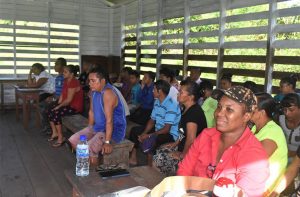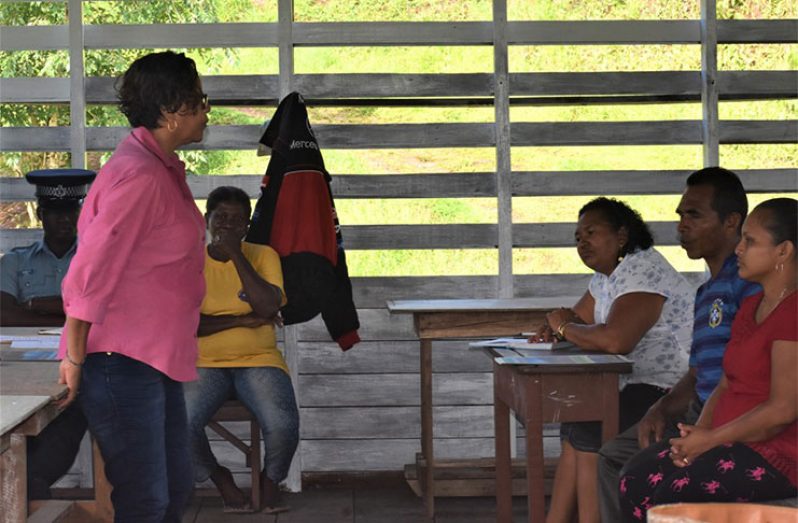RESIDENTS of Santa Cruz, Moruca sub-district have been taught improved planting techniques as they venture into value-added agriculture production.
They learnt the valuable skills during an interaction with a team from the Ministry of Indigenous Peoples’ Affairs led by junior minister, Valerie Garrido-Lowe, on Saturday.
Garrido-Lowe said the aim is to ensure Santa Cruz is fully prepared to become the most industrious Fruit Juice, Jelly and Marmalade producing village in Guyana.
“Our friends who are looking for business opportunities, they will want to bring fancy fruit juice and fancy plantain chips in fancy packs and open business right here, but guess what, would it belong to us? And do you want that? So that is why we have to utilise our land and start looking at agriculture as a business. We have to start thinking that we can get rich off of agriculture”, Garrido-Lowe said.
With the expected benefits to be derived from the imminent oil sector, Minister Garrido-Lowe assured that “we will have enough people to eat what you plant and that is taking advantage of the situation, since agriculture is one of the fastest growing sectors in the world.”
Guyanese agronomist and veterinarian, Dr. Leroy Santiago, who was also a member of the team, shared improved planting techniques with farmers.
Speaking passionately about the village’s agriculture pursuits, Dr. Santiago, who grew up in the village of Imbotero, Region One, provided valuable insights into planting methods.
“You cut down a field and you burn the soil, why do you burn it? Because its tradition, our ancestors tell us we must do that … you have about 12-14 inches of leaves that have fallen for hundreds of years – compost, another two feet of organic matter and when you burn that you get Potash (K20). So you plant the first crop you get a good crop. What you did, you kill the soil and then we want to know what happened to the rest of the crop,” he said.
Dr. Santiago also shared techniques for pest control which were welcomed by the villagers.
Member of Parliament, Raynard Ward, who is also an agriculturist by profession, also took the opportunity to interact with residents.

“As long as we the government is here; I am here, I’ll try to ensure that agriculture is put alongside the oil industry because the revenues coming in from oil can help to develop our agriculture sector. Please ensure that you, as a community, put your voices together with your community leaders. Let’s not forget that agriculture is important and we need to keep it going,” he said.
Twelve farmers were selected and will be planting one-acre land (each) of several varieties of fruits.
Among the plantlets to be planted and fruit processed, packaged and marketed are cherry, orange, tangerine, lime, guava, pear, soursop, papaw, golden apple, pineapple and banana.
It is estimated that fruits will be ready to be harvested between 18 months to three years by which time a factory will be established and be fully operable.
Production will be done in keeping with international standards and Minister Garrido-Lowe has underscored government’s commitment to continue providing the support needed to ensure the project is sustained, villagers are gainfully employed, physical and infrastructural development realised and the goal of ensuring food security is achieved.
The Fruit Farm will complement Kwebanna’s Cassava Processing Facility and the Santa Rosa Ground Coffee Project, both in the Moruca sub-district and the Smith Creek Fish and Crab Processing Facility in the Mabaruma Sub-district, all viable economic projects piloted by Minister Garrido-Lowe.
This will ultimately lead to poverty reduction which is on the front burner of the David Granger-led Coalition Government.
Santa Cruz is home to more than 400 hundred residents who are involved in farming and fishing as their main economic activities.




.jpg)









